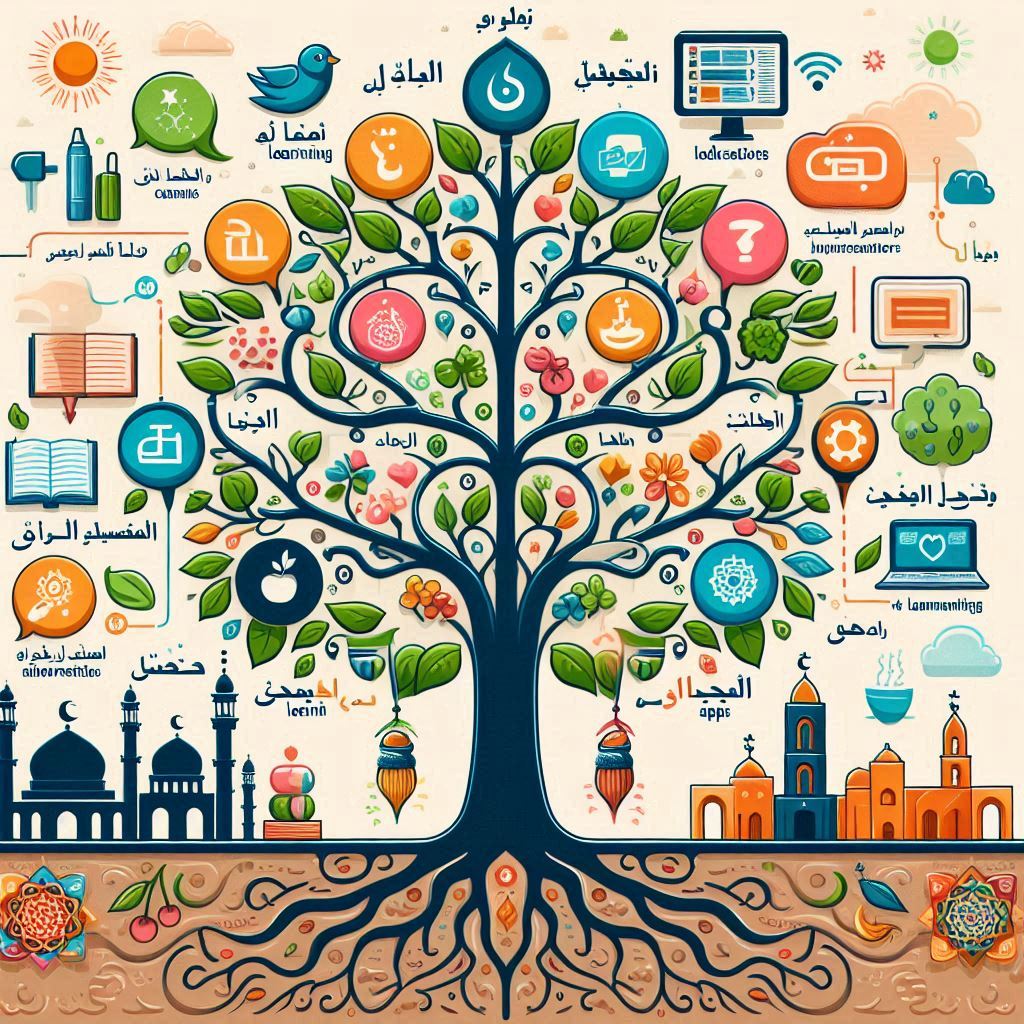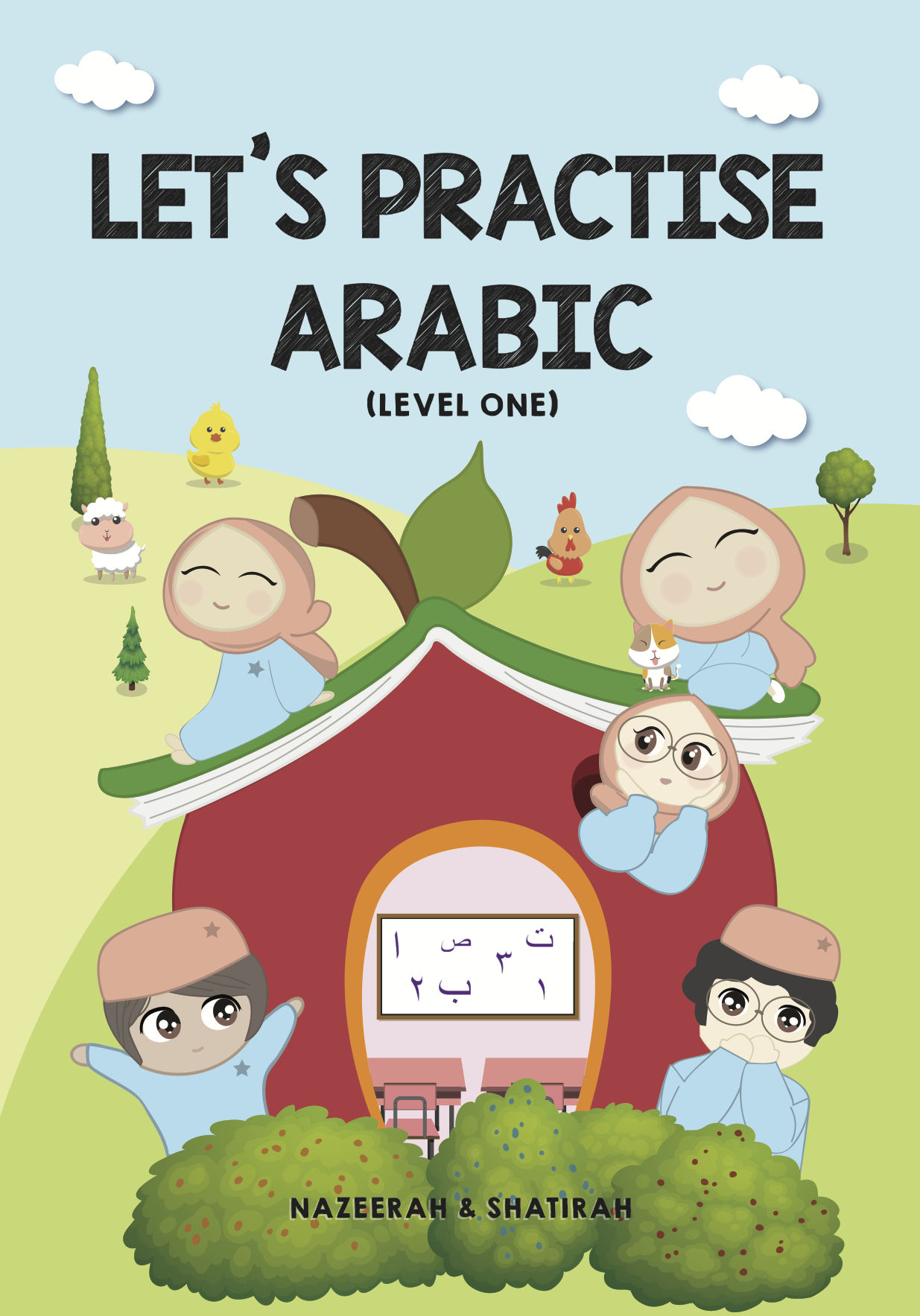Arabic, with its rich history and profound cultural significance, is not just a language but a bridge to myriad opportunities and deep cultural understanding. For children, particularly those in environments like Singapore, where diverse linguistic skills are immensely valued, Arabic can open doors to personal growth and global perspectives. As parents, you are the key to empowering your child’s journey in learning Arabic. This guide aims to provide you with essential insights and practical tools to support your child effectively. From overcoming the initial hurdles to integrating fun and engaging learning techniques, we will explore how you can be a pivotal part of your child’s Arabic learning adventure, ensuring they learn the language and embrace the culture with enthusiasm and respect.
Understanding the Basics of Arabic Language
Arabic is a rich and complex language with deep historical roots in religious, cultural, and intellectual traditions across the globe. As one of the six official languages of the United Nations and spoken by over 300 million people worldwide, Arabic’s global significance is undeniable.
1. Structure of Arabic
Script and Pronunciation: Arabic is written from right to left and has 28 letters. Learning the script is crucial as it forms the basis for reading and writing.
Dialects: There are several Arabic dialects based on geographic regions, but Modern Standard Arabic (MSA) is the standardized form used in formal settings, media, and literature.
2. Importance for Children
Cognitive Benefits: Studies have shown that learning a second language like Arabic can enhance cognitive development, improve problem-solving skills, and even boost creativity.
Cultural and Religious Significance: For Muslim children, Arabic is particularly important as it is the language of the Quran. Understanding Arabic can deepen religious and cultural connections.
3. Early Language Acquisition
Foundational Learning: Starting early can help children achieve fluency more naturally. Language learning at a young age is often more effective due to the plasticity of the developing brain.
Integration into Daily Life: Incorporating Arabic into daily activities can enhance exposure and practice, making learning a part of the child’s routine.
Challenges in Arabic Learning

While the benefits of learning Arabic are substantial, the journey comes with its unique set of challenges, especially for young learners in non-native environments. Understanding these challenges can help parents and educators create more effective learning strategies.
1. Complex Script and Pronunciation
- Orthographic Depth: Arabic script is cursive, and many letters change shape depending on their position in a word. This can be daunting for beginners.
- Phonetic Challenges: Arabic includes sounds that are uncommon in many other languages, which can be difficult for learners to master without practice.
2. Dialectal Variations
- Standard vs. Colloquial: There is a significant difference between Modern Standard Arabic (used in formal and written communication) and the colloquial dialects spoken across different regions. This duality can confuse learners about when and how to use each form.
3. Cultural Context
- Cultural Nuances: Language is deeply tied to culture. For learners outside Arabic-speaking countries, missing contextual knowledge can make certain expressions and idioms hard to grasp.
4. Resource Availability
- Quality Materials: Finding high-quality, engaging educational resources in Arabic that are appropriate for children can be challenging in areas where Arabic is not the dominant language.
5. Consistency and Exposure
- Limited Exposure: Without consistent exposure to the language, progress can stagnate. Creating an immersive environment for Arabic in non-native settings is crucial but often hard to achieve.
Overcoming These Challenges
To address these challenges, it is essential to:
- Use diverse and engaging learning materials: Incorporate books, music, apps, and videos that make learning enjoyable and relevant.
- Practice regularly: Consistency is key in language learning. Even short, daily practice can make a significant difference.
- Engage with native speakers: If possible, interacting with native speakers can provide practical experience and help with proper pronunciation and usage.
- Cultural immersion: Participate in cultural events or watch Arabic media to understand the practical use of the language in its cultural context.
In the following sections, we’ll explore specific techniques and tools that can help parents support their children’s Arabic learning effectively, focusing on practical applications and real-world engagement.
Engaging Learning Techniques
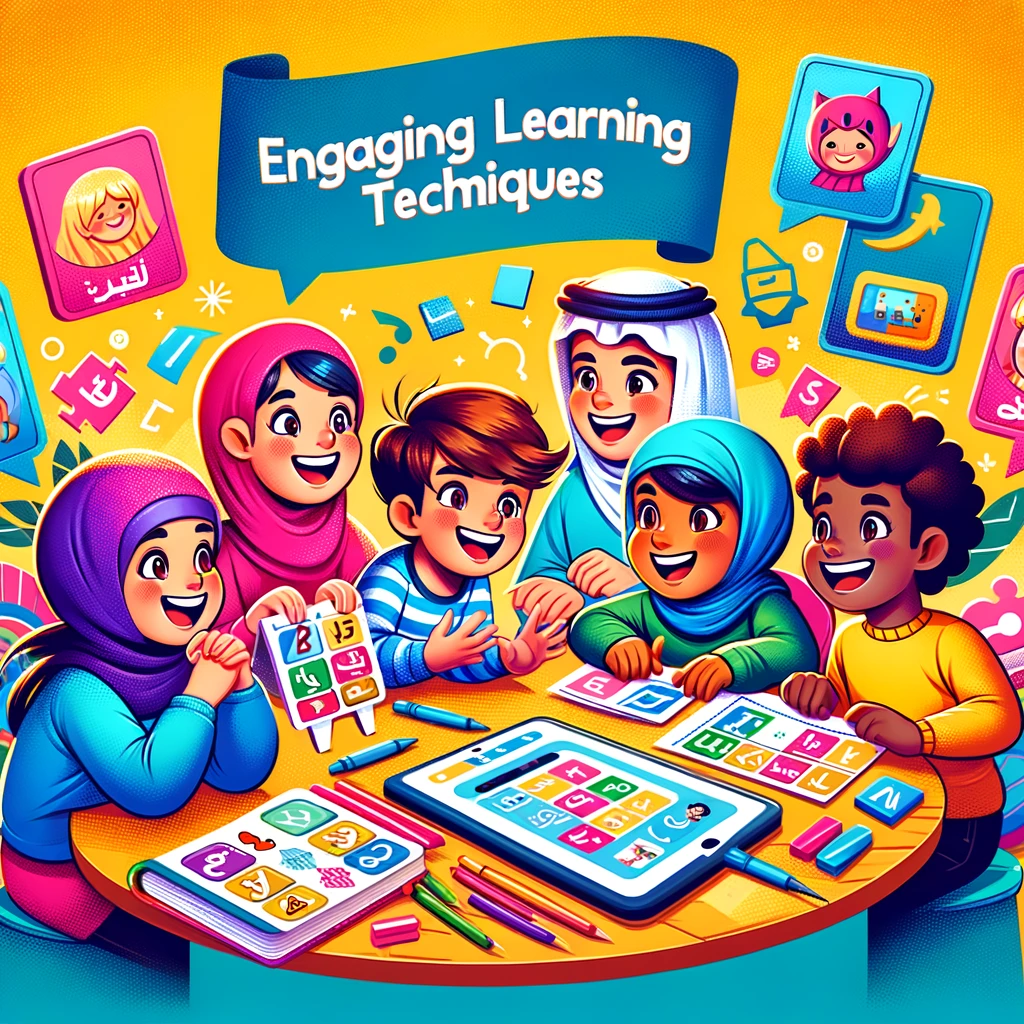
To enhance the Arabic learning experience for children, incorporating engaging and interactive techniques can significantly boost both interest and retention. Here’s how parents and educators can make the learning process both enjoyable and effective:
1. Interactive Learning Activities
- Games and Puzzles: Use Arabic language games, crossword puzzles, and word searches to make learning fun. These activities help in vocabulary building and spelling.
- Role-Playing: Encourage children to participate in role-playing exercises where they can use Arabic in everyday situations.
2. Technology Integration
- Educational Apps: Leverage apps designed for language learning that include interactive lessons, quizzes, and spoken-language practice.
- Online Videos: Incorporate educational videos that teach Arabic through songs, stories, and lessons animated for children.
3. Creative Expression
- Art and Craft: Combine language learning with creative arts, such as writing calligraphy or creating artwork that includes Arabic words and phrases.
- Music and Rhymes: Songs and rhymes are excellent for auditory learners and help in memorizing vocabulary and phrases.
4. Project-Based Learning
- Cultural Projects: Assign projects that require research and presentation in Arabic, focusing on cultural aspects such as food, festivals, and historical sites.
- Storytelling Projects: Have children create stories or plays in Arabic, which helps in using the language in a creative and practical context.
5. Regular Practice with Feedback
- Practice Sessions: Organize regular practice sessions that allow for spoken and written language practice, and provide immediate feedback to help correct mistakes.
- Language Buddy System: Pair up learners so they can practice speaking Arabic together, enhancing conversational skills.
These methods not only make learning Arabic more dynamic but also cater to different learning styles, ensuring that children remain engaged and motivated throughout their educational journey. The next section will explore how parents can actively participate and support their child’s learning process at home.
Role of Parents in Language Learning
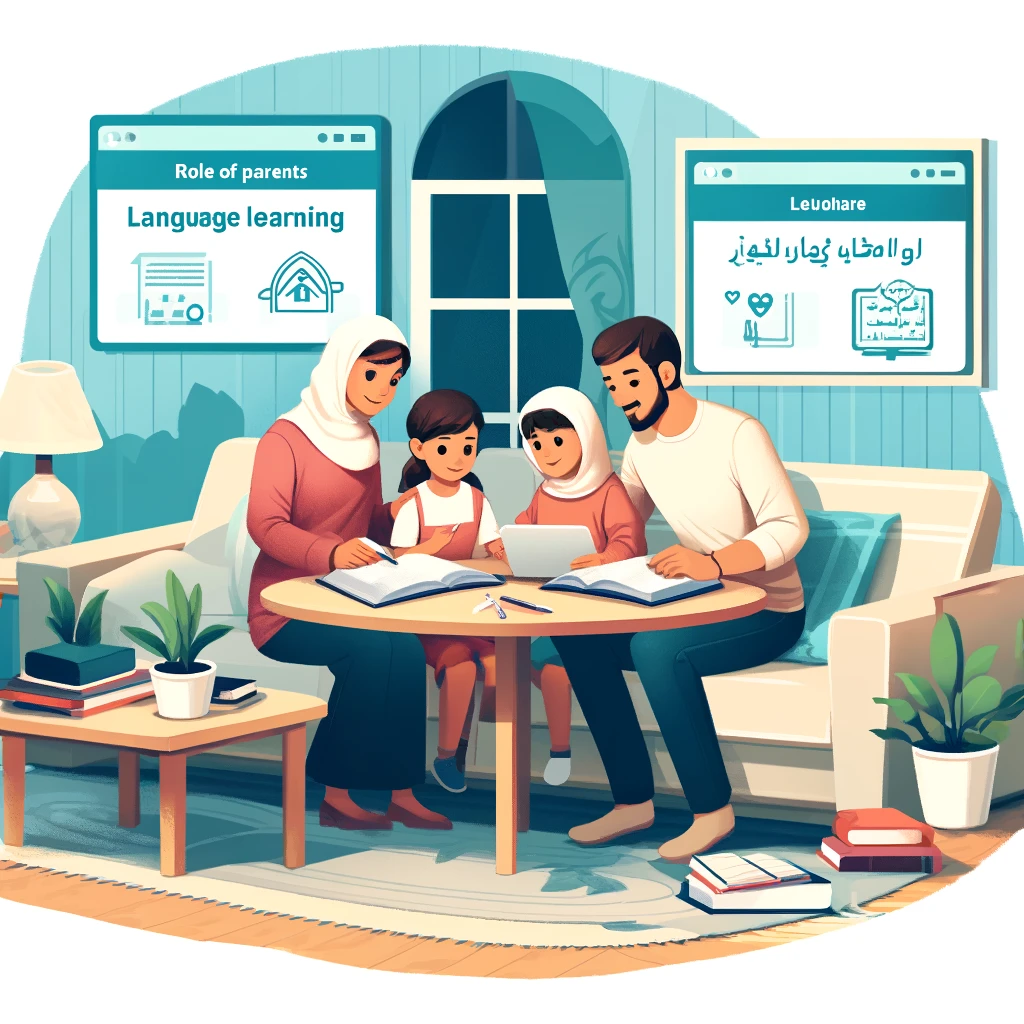
Parents play a crucial role in supporting and reinforcing their child’s language learning journey. Here’s how they can effectively contribute:
1. Active Involvement
- Participate in Learning: Join your child in learning sessions. This not only shows your support but also encourages them to stay committed.
- Use Arabic at Home: Integrate Arabic into daily conversations and routines to increase exposure and practical usage.
2. Creating a Conducive Learning Environment
- Dedicated Study Area: Set up a specific area at home that is conducive to studying. This should be a distraction-free zone with all necessary learning materials.
- Resource Accessibility: Provide access to a variety of resources, such as books, audio, and digital tools that can facilitate learning.
3. Encouragement and Motivation
- Regular Encouragement: Offer constant encouragement and recognize efforts to boost confidence and motivation.
- Rewards and Recognition: Implement a rewards system for milestones achieved in learning to keep the enthusiasm alive.
4. Engagement with Educators
- Regular Communication with Teachers: Stay in regular contact with your child’s Arabic teacher to monitor progress and receive feedback.
- Supplementary Education: Consider enrolling your child in additional classes or tutoring if needed to enhance learning outcomes.
5. Community Involvement
- Community Events: Engage with the local or online Arabic-speaking community. Attend cultural and language events that provide immersive experiences.
- Networking with Other Parents: Connect with other parents who are navigating similar educational paths. This can provide support, exchange of ideas, and even opportunities for group learning sessions.
By actively participating and creating a supportive environment, parents can significantly influence their child’s success in learning Arabic. The next sections will focus on resources and materials that can aid this learning process, ensuring that parents have the tools they need to guide their children effectively.
Resources and Materials

Choosing the right resources and materials is essential for effective Arabic learning. Here are key considerations and recommendations:
1. Selecting Appropriate Learning Materials
- Age-Appropriate Content: Ensure the materials match the learner’s age and comprehension level. For younger children, use colorful picture books and simple texts.
- Variety of Formats: Include a mix of textbooks, storybooks, digital apps, and interactive online resources to cater to different learning preferences.
2. Utilizing Digital Tools
- Educational Apps: Apps like Duolingo or Rosetta Stone offer structured language learning tailored to various levels.
- Online Platforms: Websites like BBC Arabic and Al Jazeera Learning Arabic provide comprehensive resources including videos, quizzes, and articles.
3. Community Resources
- Local Libraries and Cultural Centers: These often offer language learning materials and may host regular language classes or cultural events.
- Online Forums and Groups: Engage with online communities where learners and educators share resources and support each other.
4. Supplemental Learning Aids
- Flashcards: Use Arabic vocabulary flashcards for quick revision and reinforcement.
- Audio Resources: Listening to Arabic songs, poems, and stories can improve pronunciation and listening skills.
5. Guided and Structured Learning
- Tutors and Language Classes: Consider enrolling your child in additional classes where they can learn in a structured environment under the guidance of experienced teachers.
By carefully selecting and utilizing a range of resources and materials, parents can greatly enhance their child’s learning experience, making the process both effective and enjoyable. The final section will explore ways to immerse in community and cultural activities to further enrich this journey.
Community and Cultural Immersion
Immersing in community and cultural activities is crucial for enhancing real-world language skills and understanding cultural nuances.
1. Participating in Local Events
- Seek out Arabic cultural festivals, exhibitions, and workshops. These events provide authentic environments where children can practice the language and learn about cultural practices.
2. Engagement with Cultural Institutions
- Visit museums or cultural centers that focus on Arabic art, history, and traditions. Many offer educational programs specifically for children.
3. Community Language Groups
- Join or form language learning groups within your community. These groups can meet regularly for conversational practice and cultural exchange.
4. Cultural Exchange Programs
- Explore opportunities for your child to participate in exchange programs with Arabic-speaking countries, which can be an invaluable immersive experience.
5. Volunteer Opportunities
- Encourage participation in community service projects that involve Arabic-speaking populations. Volunteering can provide practical language use and deepen cultural understanding.
Through these immersive experiences, children not only practice Arabic in a natural setting but also develop a deeper appreciation for the culture associated with the language, enriching their learning journey. This comprehensive approach ensures that the language is learned as a living, evolving form of communication, deeply tied to its cultural roots.
Monitoring Progress and Staying Motivated
Ensuring consistent progress and maintaining motivation are key to successful language learning. Here are strategies to monitor and encourage ongoing engagement:
1. Regular Assessments
- Conduct regular informal assessments or quizzes to track vocabulary retention, comprehension, and speaking skills.
- Use apps that provide progress tracking and personalized feedback.
2. Setting Achievable Goals
- Set short-term goals that are achievable and rewarding. Celebrate when these milestones are reached to encourage further effort.
- Goals could include mastering a set number of words, completing a book, or having a conversation in Arabic.
3. Maintaining Interest
- Keep the learning journey interesting by introducing new types of learning materials and activities.
- Encourage exploration of topics of personal interest in Arabic, like sports, music, or art, to make learning more relevant and engaging.
4. Family Involvement
- Involve the entire family in learning activities, creating a supportive environment that reinforces the importance and utility of Arabic.
- Family game nights or movie evenings with Arabic-language films or documentaries can be both educational and fun.
5. Feedback and Adaptation
- Regularly seek feedback from the child on what is working or not in their learning process. Adapt strategies based on this feedback to better meet their needs.
By effectively monitoring progress and staying motivated, parents can help ensure that their child not only continues to learn Arabic but also enjoys the learning process, making it a rewarding part of their daily life.
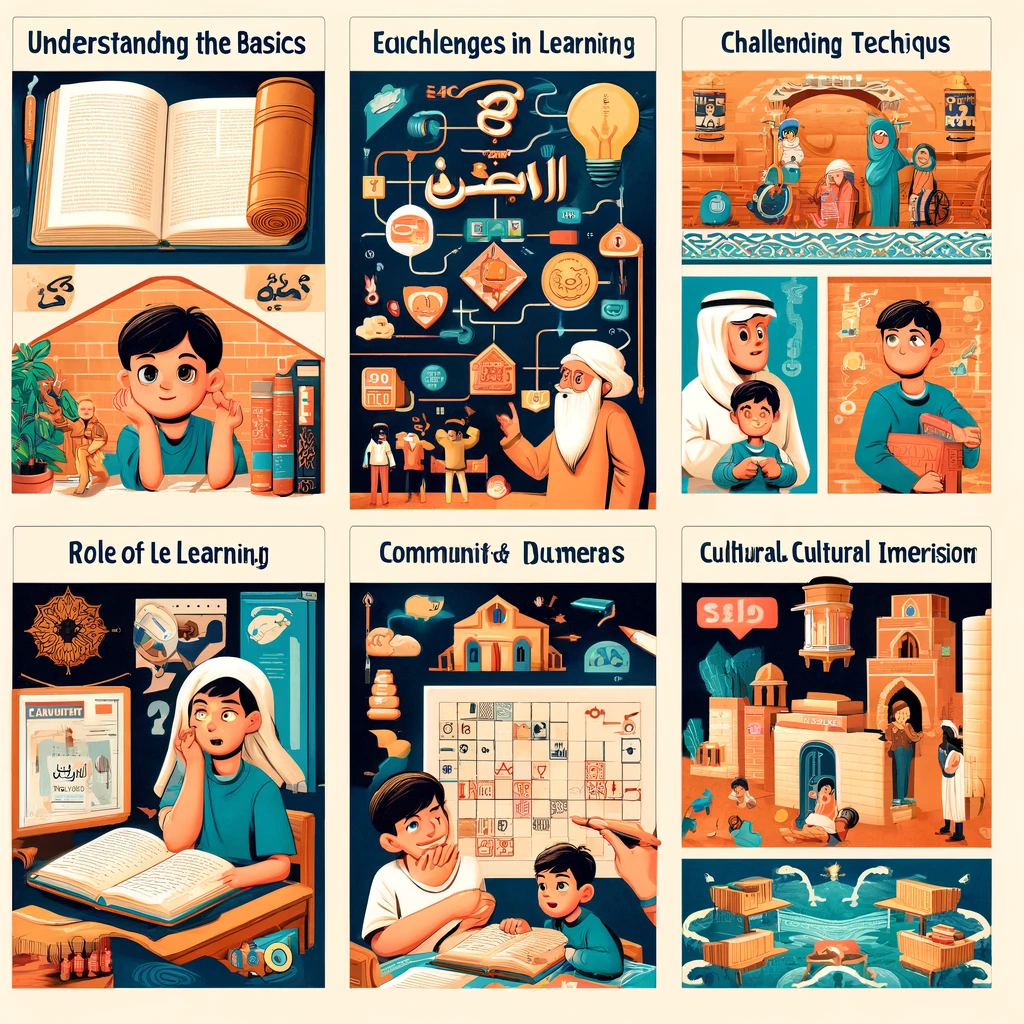
As we’ve explored throughout this guide, empowering your child’s Arabic learning journey requires a blend of appropriate resources, engaging teaching methods, and community involvement. The role of parents in this process is irreplaceable—supporting, motivating, and occasionally stepping in as co-learners. Remember, the goal is not just linguistic proficiency but also a deep appreciation for the cultural wealth that comes with the Arabic language. By fostering an environment that values regular practice and cultural immersion, you ensure that your child’s learning experience is not only educational but also enriching. Continue to celebrate every small victory along the way, and keep the journey enjoyable and inspired. Your efforts today will equip your child with skills that open new horizons in their future.

